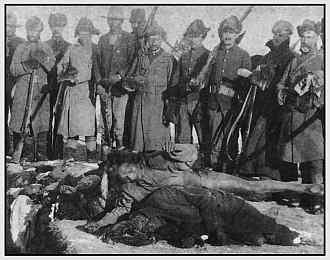A review of
Wounded Knee, a children's book by Neil Waldman, makes a good point:
The Wounded Knee Massacre and Children's BooksWaldman adopts the view of Wounded Knee as the deadly result of an unavoidable clash of cultures. In Chapter 1, which is called "Massacre," he says,
Thus ended the last battle between two proud and warring peoples. It was the inevitable conclusion of the clash between two disparate nations, the end of the culture of nomadic hunters who had roamed the great plains of North America for centuries.
Waldman's book has been praised as "sympathetic" and "balanced" and "nonjudgmental." Yet how can one present a "balanced" picture of a tragedy that is still being mourned more than 110 years later? On the scale of justice, some things are heavier than others, and genocide is one of them. The basic struggle between the Native peoples and the encroaching Europeans is not difficult to summarize: while Indian peoples were struggling to maintain land, culture, and community, the whites were trying to take it all away--which they did, by murder, germ warfare, and wholesale kidnapping of children. How can anyone with integrity give a "balanced" account of that reality?Comment: A few problems with Waldman's summary. One, Wounded Knee was a massacre, not a battle. Two, one side was warring in violation of signed treaties and civilized norms; the other was "warring" in self-defense to protect its way of life. Three, Indian cultures didn't end; they evolved into something new. Four, the "nomadic hunters" of the Plains were only a fraction of the Indians who suffered because of America's immoral aggression. A lot of peaceful Indians--who lived in villages and farmed or fished--suffered too.
Waldman sounds like he'd be a fan of HBO's
Bury My Heart at Wounded Knee. His version of history is reminiscent of Dick Wolf's.
For more on the subject, see
Genocide by Any Other Name....



No comments:
Post a Comment